Cohen I.M., Kundu P.K. Fluid Mechanics
Подождите немного. Документ загружается.

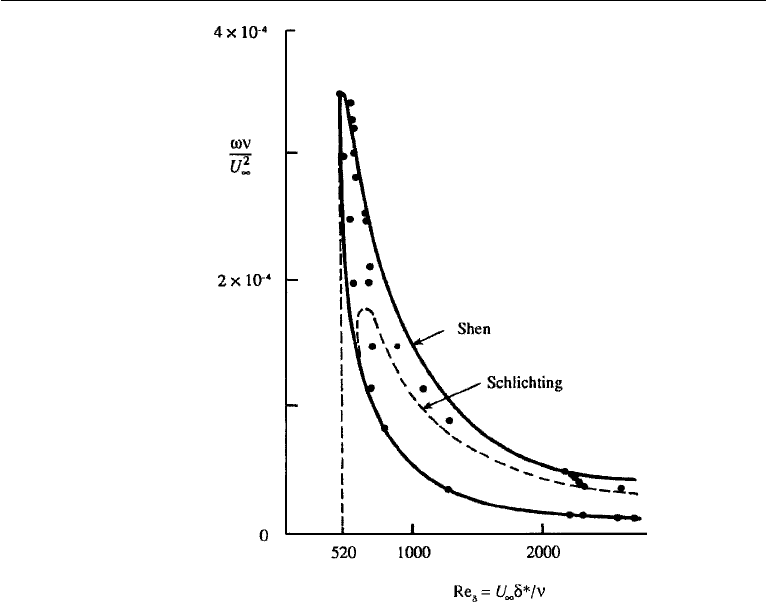
522 Instability
Figure 12.26 Marginal stability curve for a Blasius boundary layer. Theoretical solutions of Shen and
Schlichting are compared with experimental data of Schubauer and Skramstad.
Reshotko (2001) provides a review of temporally and spatially transient growth as
a path from subcritical (Tollmien–Schlichting) disturbances to transition. Growth or
decay is studied from the Orr–Sommerfeld and Squire equations. Growth may occur
because eigenfunctions of these equations are not orthogonal as the operators are not
self-adjoint. Results for Poiseuille pipe flow and compressible blunt body flows are
given.
Fransson and Alfredsson (2003) have shown that the asymptotic suction profile
[solved in Exercise 9, Chapter 10] significantly delays transition stimulated by free
stream turbulence or by Tollmien-Schlichting waves. Specifically, the value of Re
cr
=
520 based on δ
∗
in Table 12.1 is increased for suction velocity ratio to v
o
/U
∞
=
−.00288 over 54000. The very large stabilizing effect is a result of the change in
the shape of the streamwise velocity from the Blasius profile to an exponential. The
normal suction velocity has a very small effect on stability.
12. Comments on Nonlinear Effects
To this point we have discussed only linear stability theory, which considers infinites-
imal perturbations and predicts exponential growth when the relevant parameter

13. Transition 523
exceeds a critical value. The effect of the perturbations on the basic field is neglected in
the linear theory. An examination of equation (12.83) shows that the perturbation field
must be such that the mean Reynolds stress
uv (the “mean” being over a wavelength)
be nonzero for the perturbations to extract energy from the basic shear; similarly, the
heat flux
uT
must be nonzero in a thermal convection problem. These rectified fluxes
of momentum and heat change the basic velocity and temperature fields. The linear
instability theory neglects these changes of the basic state. A consequence of the con-
stancy of the basic state is that the growth rate of the perturbations is also constant,
leading to an exponential growth. Within a short time of such initial growth the pertur-
bations become so large that the rectified fluxes of momentum and heat significantly
change the basic state, which in turn alters the growth of the perturbations.
A frequent effect of nonlinearity is to change the basic state in such a way as
to stop the growth of the disturbances after they have reached significant amplitude
through the initial exponential growth. (Note, however, that the effect of nonlinearity
can sometimes be destabilizing; for example, the instability in a pipe flow may be
a finite amplitude effect because the flow is stable to infinitesimal disturbances.)
Consider the thermal convection in the annular space between two vertical cylinders
rotating at the same speed. The outer wall of the annulus is heated and the inner wall
is cooled. For small heating rates the flow is steady. For large heating rates a system of
regularly spaced waves develop and progress azimuthally at a uniform speed without
changing their shape. (This is the equilibrated form of baroclinic instability, discussed
in Chapter 14, Section 17.) At still larger heating rates an irregular, aperiodic, or
chaotic flow develops. The chaotic response to constant forcing (in this case the
heating rate) is an interesting nonlinear effect and is discussed further in Section 14.
Meanwhile, a brief description of the transition from laminar to turbulent flow is given
in the next section.
13. Transition
The process by which a laminar flow changes to a turbulent one is called transition.
Instability of a laminar flow does not immediately lead to turbulence, which is a
severely nonlinear and chaotic stage characterized by macroscopic “mixing” of fluid
particles.After the initial breakdown of laminar flow because of amplification of small
disturbances, the flow goes through a complex sequence of changes, finally resulting
in the chaotic state we call turbulence. The process of transition is greatly affected by
such experimental conditions as intensity of fluctuations of the free stream, roughness
of the walls, and shape of the inlet. The sequence of events that lead to turbulence is
also greatly dependent on boundary geometry. For example, the scenario of transition
in a wall-bounded shear flow is different from that in free shear flows such as jets
and wakes.
Early stages of the transition consist of a succession of instabilities on increas-
ingly complex basic flows, an idea first suggested by Landau in 1944. The basic
state of wall-bounded parallel shear flows becomes unstable to two-dimensional TS
waves, which grow and eventually reach equilibrium at some finite amplitude. This
steady state can be considered a new background state, and calculations show that
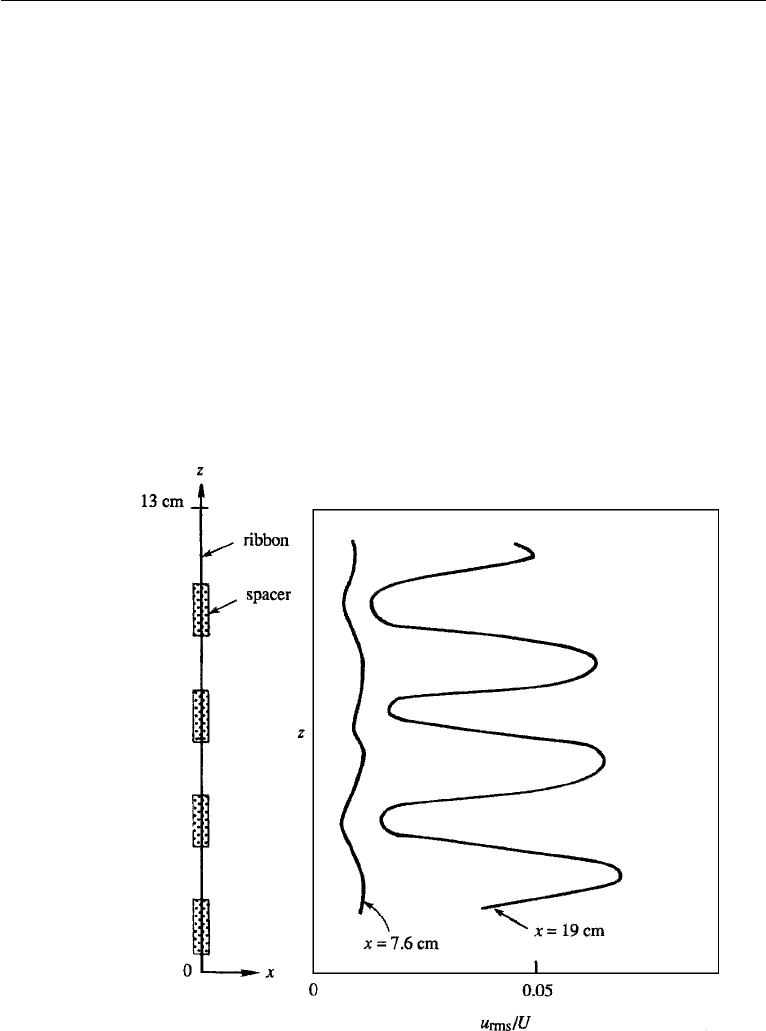
524 Instability
it is generally unstable to three-dimensional waves of short wavelength, which vary
in the “spanwise” direction. (If x is the direction of flow and y is the directed nor-
mal to the boundary, then the z-axis is spanwise.) We shall call this the secondary
instability. Interestingly, the secondary instability does not reach equilibrium at finite
amplitude but directly evolves to a fully turbulent flow. Recent calculations of the
secondary instability have been quite successful in reproducing critical Reynolds
numbers for various wall-bounded flows, as well as predicting three-dimensional
structures observed in experiments.
A key experiment on the three-dimensional nature of the transition process in a
boundary layer was performed by Klebanoff, Tidstrom, and Sargent (1962). They con-
ducted a series of controlled experiments by which they introduced three-dimensional
disturbances on a field of TS waves in a boundary layer. The TS waves were as usual
artificially generated by an electromagnetically vibrated ribbon, and the three dimen-
sionality of a particular spanwise wavelength was introduced by placing spacers
(small pieces of transparent tape) at equal intervals underneath the vibrating ribbon
(Figure 12.27). When the amplitude of the TS waves became roughly 1% of the
free-stream velocity, the three-dimensional perturbations grew rapidly and resulted
Figure 12.27 Three-dimensional unstable waves initiated by vibrating ribbon. Measured distributions of
intensity of the u-fluctuation at two distances from the ribbon are shown. P. S. Klebanoff et al., Journal of
Fluid Mechanics 12: 1–34, 1962 and reprinted with the permission of Cambridge University Press.

14. Deterministic Chaos 525
in a spanwise irregularity of the streamwise velocity displaying peaks and valleys
in the amplitude of u. The three-dimensional disturbances continued to grow until
the boundary layer became fully turbulent. The chaotic flow seems to result from the
nonlinear evolution of the secondary instability, and recent numerical calculations
have accurately reproduced several characteristic features of real flows (see Figures 7
and 8 in Bayly et al., 1988).
It is interesting to compare the chaos observed in turbulent shear flows with
that in controlled low-order dynamical systems such as the B´ernard convection or
Taylor vortex flow. In these low-order flows only a very small number of modes
participate in the dynamics because of the strong constraint of the boundary con-
ditions. All but a few low modes are identically zero, and the chaos develops in
an orderly way. As the constraints are relaxed (we can think of this as increas-
ing the number of allowed Fourier modes), the evolution of chaos becomes less
orderly.
Transition in a free shear layer, such as a jet or a wake, occurs in a different manner.
Because of the inflectional velocity profiles involved, these flows are unstable at a very
low Reynolds numbers, that is, of order 10 compared to about 10
3
for a wall-bounded
flow. The breakdown of the laminar flow therefore occurs quite readily and close
to the origin of such a flow. Transition in a free shear layer is characterized by the
appearance of a rolled-up row of vortices, whose wavelength corresponds to the one
with the largest growth rate. Frequently, these vortices group themselves in the form
of pairs and result in a dominant wavelength twice that of the original wavelength.
Small-scale turbulence develops within these larger scale vortices, finally leading to
turbulence.
14. Deterministic Chaos
The discussion in the previous section has shown that dissipative nonlinear systems
such as fluid flows reach a random or chaotic state when the parameter measuring
nonlinearity (say, the Reynolds number or the Rayleigh number) is large. The change
to the chaotic stage generally takes place through a sequence of transitions, with the
exact route depending on the system. It has been realized that chaotic behavior not only
occurs in continuous systems having an infinite number of degrees of freedom, but
also in discrete nonlinear systems having only a small number of degrees of freedom,
governed by ordinary nonlinear differential equations. In this context, a chaotic system
is defined as one in which the solution is extremely sensitive to initial conditions. That
is, solutions with arbitrarily close initial conditions evolve into quite different states.
Other symptoms of a chaotic system are that the solutions are aperiodic, and that the
spectrum is broadband instead of being composed of a few discrete lines.
Numerical integrations (to be shown later in this section) have recently demon-
strated that nonlinear systems governed by a finite set of deterministic ordinary dif-
ferential equations allow chaotic solutions in response to a steady forcing. This fact is
interesting because in a dissipative linear system a constant forcing ultimately (after
the decay of the transients) leads to constant response, a periodic forcing leads to
periodic response, and a random forcing leads to random response. In the presence

526 Instability
of nonlinearity, however, a constant forcing can lead to a variable response, both
periodic and aperiodic. Consider again the experiment mentioned in Section 12,
namely, the thermal convection in the annular space between two vertical cylinders
rotating at the same speed. The outer wall of the annulus is heated and the inner wall
is cooled. For small heating rates the flow is steady. For large heating rates a system
of regularly spaced waves develops and progresses azimuthally at a uniform speed,
without the waves changing shape. At still larger heating rates an irregular, aperiodic,
or chaotic flow develops. This experiment shows that both periodic and aperiodic flow
can result in a nonlinear system even when the forcing (in this case the heating rate)
is constant. Another example is the periodic oscillation in the flow behind a blunt
body at Re ∼ 40 (associated with the initial appearance of the von Karman vortex
street) and the breakdown of the oscillation into turbulent flow at larger values of the
Reynolds number.
It has been found that transition to chaos in the solution of ordinary nonlinear
differential equations displays a certain universal behavior and proceeds in one of a
few different ways. At the moment it is unclear whether the transition in fluid flows is
closely related to the development of chaos in the solutions of these simple systems;
this is under intense study. In this section we shall discuss some of the elementary
ideas involved, starting with certain definitions. An introduction to the subject of
chaos is given by Berg´e, Pomeau, and Vidal (1984); a useful review is given in
Lanford (1982). The subject has far-reaching cosmic consequences in physics and
evolutionary biology, as discussed by Davies (1988).
Phase Space
Very few nonlinear equations have analytical solutions. For nonlinear systems, a
typical procedure is to find a numerical solution and display its properties in a space
whose axes are the dependent variables. Consider the equation governing the motion
of a simple pendulum of length l:
¨
X +
g
l
sin X = 0,
where X is the angular displacement and
¨
X(= d
2
X/dt
2
) is the angular acceleration.
(The component of gravity parallel to the trajectory is −g sin X, which is balanced by
the linear acceleration l
¨
X.) The equation is nonlinear because of the sin X term. The
second-order equation can be split into two coupled first-order equations
˙
X = Y,
˙
Y =−
g
l
sin X.
(12.84)
Starting with some initial conditions on X and Y , one can integrate set (12.84). The
behavior of the system can be studied by describing how the variables Y (=
˙
X) and X
vary as a function of time. For the pendulum problem, the space whose axes are
˙
X and
X is called a phase space, and the evolution of the system is described by a trajectory
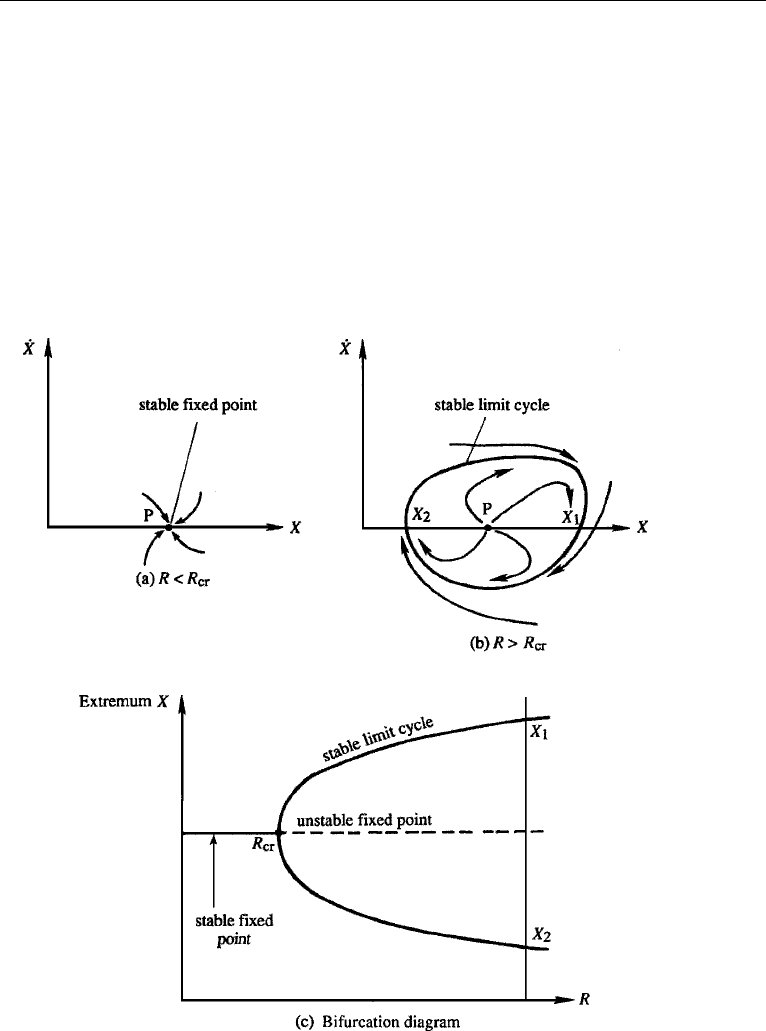
14. Deterministic Chaos 527
in this space. The dimension of the phase space is called the degree of freedom of the
system; it equals the number of independent initial conditions necessary to specify
the system. For example, the degree of freedom for the set (12.84) is two.
Attractor
Dissipative systems are characterized by the existence of attractors, which are struc-
tures in the phase space toward which neighboring trajectories approach as t →∞.
An attractor can be a fixed point representing a stable steady flow or a closed
curve (called a limit cycle) representing a stable oscillation (Figure 12.28a, b). The
nature of the attractor depends on the value of the nonlinearity parameter, which
Figure 12.28 Attractors in a phase plane. In (a), point P is an attractor. For a larger value of R, panel
(b) shows that P becomes an unstable fixed point (a “repeller”), and the trajectories are attracted to a limit
cycle. Panel (c) is the bifurcation diagram.

528 Instability
will be denoted by R in this section. As R is increased, the fixed point represent-
ing a steady solution may change from being an attractor to a repeller with spi-
rally outgoing trajectories, signifying that the steady flow has become unstable to
infinitesimal perturbations. Frequently, the trajectories are then attracted by a limit
cycle, which means that the unstable steady solution gives way to a steady oscil-
lation (Figure 12.28b). For example, the steady flow behind a blunt body becomes
oscillatory as Re is increased, resulting in the periodic von Karman vortex street
(Figure 10.18).
The branching of a solution at a critical value R
cr
of the nonlinearity parameter
is called a bifurcation. Thus, we say that the stable steady solution of Figure 12.28a
bifurcates to a stable limit cycle as R increases through R
cr
. This can be represented
on the graph of a dependent variable (say, X)vsR (Figure 12.28c). At R = R
cr
, the
solution curve branches into two paths; the two values of X on these branches (say,
X
1
and X
2
) correspond to the maximum and minimum values of X in Figure 12.28b.
It is seen that the size of the limit cycle grows larger as (R − R
cr
) becomes larger.
Limit cycles, representing oscillatory response with amplitude independent of initial
conditions, are characteristic features of nonlinear systems. Linear stability theory
predicts an exponential growth of the perturbations if R>R
cr
, but a nonlinear theory
frequently shows that the perturbations eventually equilibrate to a steady oscillation
whose amplitude increases with (R − R
cr
).
The Lorenz Model of Thermal Convection
Taking the example of thermal convection in a layer heated from below (the B´enard
problem), Lorenz (1963) demonstrated that the development of chaos is associated
with the attractor acquiring certain strange properties. He considered a layer with
stress-free boundaries. Assuming nonlinear disturbances in the form of rolls invariant
in the y direction, and defining a streamfunction in the xz-plane by u =−∂ψ/∂z and
w = ∂ψ/∂x, he substituted solutions of the form
ψ ∝ X(t) cos πzsin kx,
T
∝ Y(t)cos πzcos kx + Z(t) sin 2πz,
(12.85)
into the equations of motion (12.7). Here, T
is the departure of temperature from the
state of no convection, k is the wavenumber of the perturbation, and the boundaries
are at z =±
1
2
. It is clear that X is proportional to the intensity of convective motion, Y
is proportional to the temperature difference between the ascending and descending
currents, and Z is proportional to the distortion of the average vertical profile of
temperature from linearity. (Note in equation (12.85) that the x-average of the term
multiplied by Y(t) is zero, so that this term does not cause distortion of the basic
temperature profile.) As discussed in Section 3, Rayleigh’s linear analysis showed that
solutions of the form (12.85), with X and Y constants and Z = 0, would develop if Ra
slightly exceeds the critical value Ra
cr
= 27 π
4
/4. Equations (12.85) are expected to
give realistic results when Ra is slightly supercritical but not when strong convection
occurs because only the lowest terms in a “Galerkin expansion” are retained.
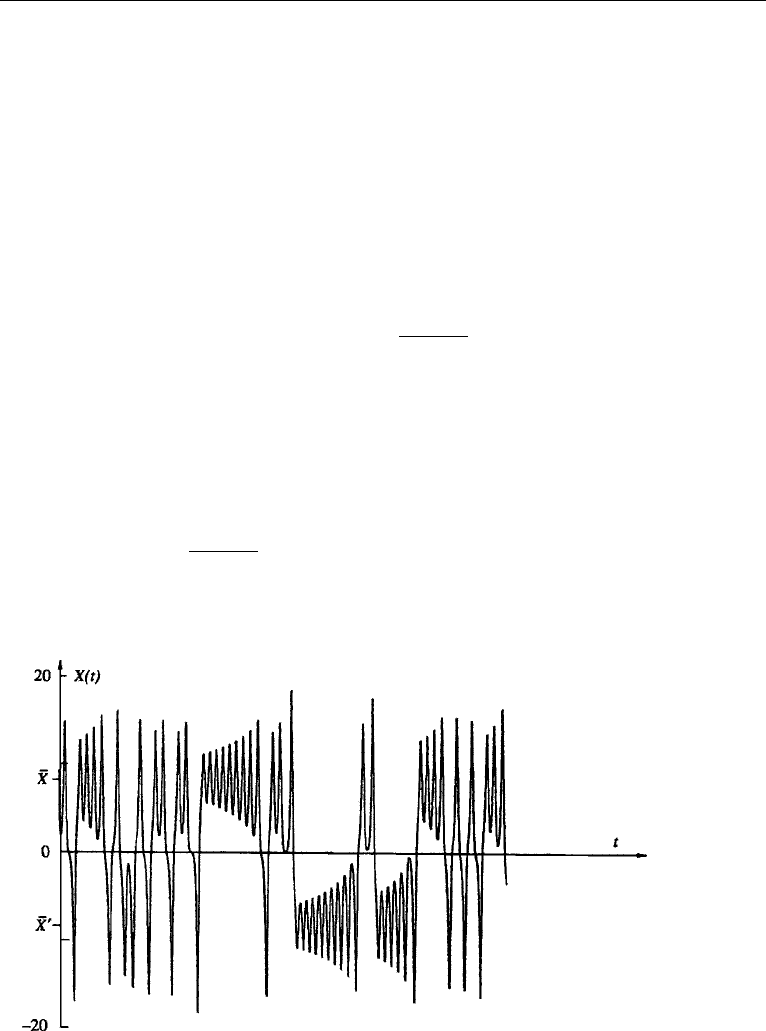
14. Deterministic Chaos 529
On substitution of equation (12.85) into the equations of motion, Lorenz finally
obtained
˙
X = Pr(Y − X),
˙
Y =−XZ + rX − Y,
˙
Z = XY − bZ,
(12.86)
where Pr is the Prandtl number, r = Ra/Ra
cr
, and b = 4π
2
/(π
2
+ k
2
). Equations
(12.86) represent a set of nonlinear equations with three degrees of freedom, which
means that the phase space is three-dimensional.
Equations (12.86) allow the steady solution X = Y = Z = 0, representing the
state of no convection. For r>1 the system possesses two additional steady-state
solutions, which we shall denote by
¯
X =
¯
Y =±
√
b(r − 1),
¯
Z = r −1; the two signs
correspond to the two possible senses of rotation of the rolls. (The fact that these steady
solutions satisfy equation (12.86) can easily be checked by substitution and setting
˙
X =
˙
Y =
˙
Z = 0.) Lorenz showed that the steady-state convection becomes unstable
if r is large. Choosing Pr = 10, b = 8/3, and r = 28, he numerically integrated the
set and found that the solution never repeats itself; it is aperiodic and wanders about
in a chaotic manner. Figure 12.29 shows the variation of X(t), starting with some
initial conditions. (The variables Y(t) and Z(t) also behave in a similar way.) It is
seen that the amplitude of the convecting motion initially oscillates around one of the
steady values
¯
X =±
√
b(r − 1), with the oscillations growing in magnitude. When
it is large enough, the amplitude suddenly goes through zero to start oscillations of
opposite sign about the other value of
¯
X. That is, the motion switches in a chaotic
Figure 12.29 Variation of X(t) in the Lorenz model. Note that the solution oscillates erratically around
the two steady values
¯
X and
¯
X
. P. Berg´e,Y. Pomeau, and C.Vidal, Order Within Chaus, 1984 and reprinting
permitted by Heinemann Educational, a division of Reed Educational & Professional Publishing Ltd.
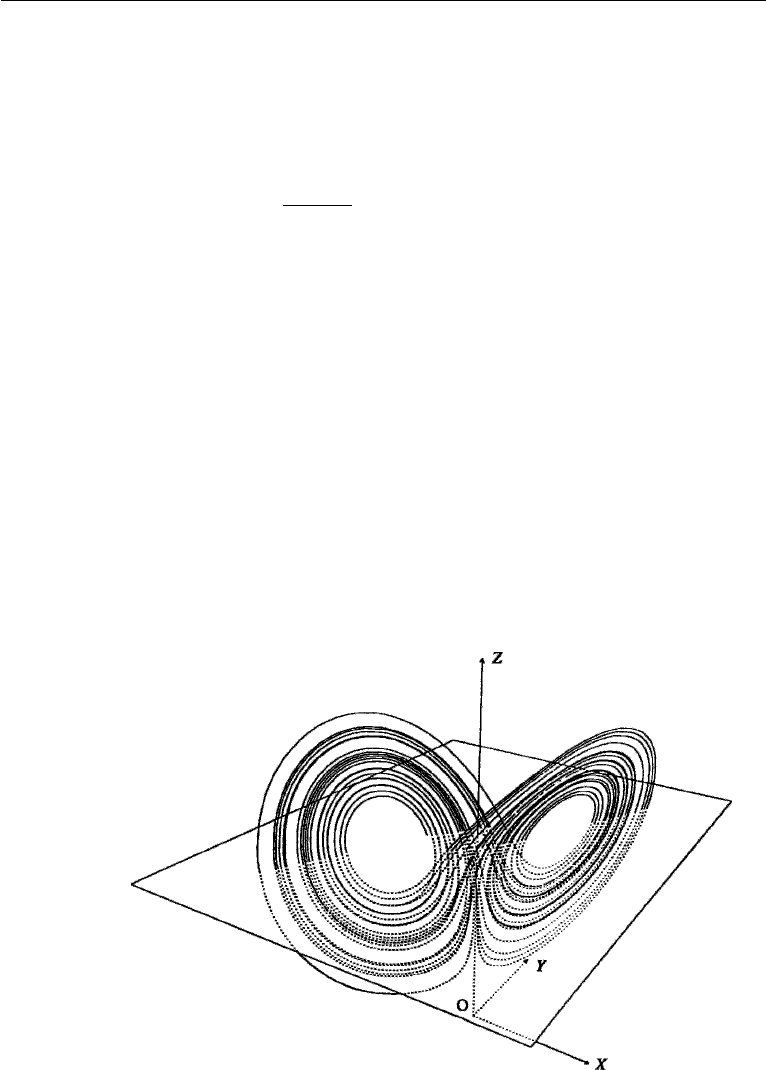
530 Instability
manner between two oscillatory limit cycles, with the number of oscillations between
transitions seemingly random. Calculations show that the variables X, Y , and Z have
continuous spectra and that the solution is extremely sensitive to initial conditions.
Strange Attractors
The trajectories in the phase plane in the Lorenz model of thermal convection are
shown in Figure 12.30. The centers of the two loops represent the two steady con-
vections
¯
X =
¯
Y =±
√
b(r − 1),
¯
Z = r − 1. The structure resembles two rather flat
loops of ribbon, one lying slightly in front of the other along a central band with the
two joined together at the bottom of that band. The trajectories go clockwise around
the left loop and counterclockwise around the right loop; two trajectories never inter-
sect. The structure shown in Figure 12.30 is an attractor because orbits starting with
initial conditions outside of the attractor merge on it and then follow it. The attraction
is a result of dissipation in the system. The aperiodic attractor, however, is unlike the
normal attractor in the form of a fixed point (representing steady motion) or a closed
curve (representing a limit cycle). This is because two trajectories on the aperiodic
attractor, with infinitesimally different initial conditions, follow each other closely
only for a while, eventually diverging to very different final states. This is the basic
reason for sensitivity to initial conditions.
For these reasons the aperiodic attractor is called a strange attractor. The idea of
a strange attractor is quite nonintuitive because it has the dual property of attraction
and divergence. Trajectories are attracted from the neighboring region of phase space,
but once on the attractor the trajectories eventually diverge and result in chaos. An
ordinary attractor “forgets” slightly different initial conditions, whereas the strange
Figure 12.30 The Lorenz attractor. Centers of the two loops represent the two steady solutions (
¯
X,
¯
Y,
¯
Z).

14. Deterministic Chaos 531
attractor ultimately accentuates them. The idea of the strange attractor was first
conceived by Lorenz, and since then attractors of other chaotic systems have also
been studied. They all have the common property of aperiodicity, continuous spectra,
and sensitivity to initial conditions.
Scenarios for Transition to Chaos
Thus far we have studied discrete dynamical systems having only a small number
of degrees of freedom and seen that aperiodic or chaotic solutions result when the
nonlinearity parameter is large. Several routes or scenarios of transition to chaos in
such systems have been identified. Two of these are described briefly here.
(1) Transition through subharmonic cascade:AsR is increased, a typical non-
linear system develops a limit cycle of a certain frequency ω. With further
increase of R, several systems are found to generate additional frequencies
ω/2, ω/4, ω/8,.... The addition of frequencies in the form of subhar-
monics does not change the periodic nature of the solution, but the period
doubles each time a lower harmonic is added. The period doubling takes
place more and more rapidly as R is increased, until an accumulation point
(Figure 12.31) is reached, beyond which the solution wanders about in a chaotic
manner. At this point the peaks disappear from the spectrum, which becomes
continuous. Many systems approach chaotic behavior through period doubling.
Feigenbaum (1980) proved the important result that this kind of transition
develops in a universal way, independent of the particular nonlinear systems
studied. If R
n
represents the value for development of a new subharmonic,
then R
n
converges in a geometric series with
R
n
− R
n−1
R
n+1
− R
n
→ 4.6692 as n →∞.
That is, the horizontal gap between two bifurcation points is about a fifth of the
previous gap. The vertical gap between the branches of the bifurcation diagram
also decreases, with each gap about two-fifths of the previous gap. In other
words, the bifurcation diagram (Figure 12.31) becomes “self similar” as the
accumulation point is approached. (Note that Figure 12.31 has not been drawn
to scale, for illustrative purposes.) Experiments in low Prandtl number fluids
(such as liquid metals) indicate that B´enard convection in the form of rolls
develops oscillatory motion of a certain frequency ω at Ra = 2Ra
cr
.AsRais
further increased, additional frequencies ω/2, ω/4, ω/8, ω/16, and ω/32 have
been observed. The convergence ratio has been measured to be 4.4, close to the
value of 4.669 predicted by Feigenbaum’s theory. The experimental evidence
is discussed further in Berg´e, Pomeau, and Vidal (1984).
(2) Transition through quasi-periodic regime: Ruelle and Takens (1971) have
mathematically proved that certain systems need only a small number of
bifurcations to produce chaotic solutions. As the nonlinearity parameter is
increased, the steady solution loses stability and bifurcates to an oscillatory
